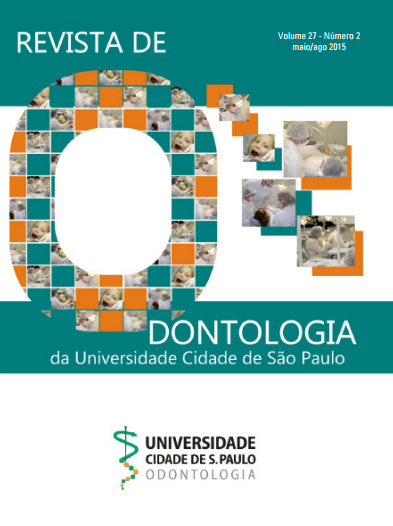Avaliação do volume do disco articular da atm por meio de imagens de ressonância magnética usando um software de análise de imagem
DOI:
https://doi.org/10.26843/ro_unicid.v27i2.262Palavras-chave:
Articulação temporomandibular, Processamento de imagem assistida por computador, Imagem por ressonância magnética.Resumo
O objetivo deste estudo foi verificar a variação do volume do disco articular da ATM em pacientes com DTM e em indivíduos de controle, correlacionando-a com diagnóstico de imagem de RM e com dados clínicos. Foram analisados 29 exames de ressonância magnética entre pacientes e controles, totalizando 58 ATMs, em cortes sagitais sequenciais das imagens de RM. O software livre MRIcro foi utilizado para delineamento manual dos limites anatômicos do disco articular e obtenção o volume do disco. Para analisar a correlação entre os volumes dos discos e as variáveis clínicas e por imagem, empregou-se o teste de Kruskal-Wallis. Para caracterizar e comparar as variáveis entre gênero e idade foi aplicado o Teste t de Student independente. Observou-se uma correlação entre o deslocamento do disco (p-valor = 0.001 para ATM direita e p-valor = 0.002 para ATM esquerda) e o volume do disco, que aumentou significativamente no grupo de pacientes. Não foi encontrada associação significativa entre gênero e volume dos discos direito e esquerdo (respectivamente; p-valor = 0,640 e 0,390). Concluiu-se que o volume do disco articular aumentou com a presença de desarranjo intra-articular.Downloads
Referências
Tallents RH, Katzberg RW, Murphy W, Proskin H. Magnetic resonance imaging findings in asymptomatic volunteers and symptomatic patients with temporomandibular disorders. J Prosthet Dent 1996 May;75(5):529-33.
Thompson JR. Triad of dentistry: diagnosis and treatment. United States of America: Northwestern University Dental School; 1994.
Bumann A, Lotzmann U. Disfunção temporomandibular: diagnóstico funcional e princípios terapêuticos. In: Atlas colorido de odontologia. Porto Alegre: Artmed; 2002.
Costa AL, Yasuda CL, Appenzeller S, Lopes SL, Cendes F. Comparison of conventional MRI and 3D reconstruction model for evaluation of temporomandibular joint. Surg Radiol Anat 2008 Nov;30(8):663-7.
Heffez LB, Mafee M, Rosenberg H. Atlas of temporomandibular joint imaging. EUA: Lippincott Williams and Wilkins; 1995
Amaral R O, Damasceno NN, de Souza LA, Devito KL. Magnetic resonance images of patients with temporomandibular disorders: prevalence and correlation between disk morphology and displacement. Eur J Radiol 2013 Jun;82(6):990-4.
Costa AL, D? Abreu A, Cendes F. Temporomandibular joint internal derangement: association with headache, joint effusion, bruxism, and joint pain. J Contemp Dent Pract 2008 9(6):9-16
Taskaya-Yilmaz N, Ogutcen-Toller M. Magnetic resonance imaging evaluation of temporomandibular joint disc deformities in relation to type of disc displacement. J Oral Maxillofac Surg 2001 Aug;59(8):860-5; discussion 5-6.
Porto VC. Avaliação da posição do disco articular em pacientes usuários de dentaduras duplas e portadores de sons articulares por meio de ressonância magnética da ATM [Tese]. Bauru, SP: Faculdade de Odontologia de Bauru; 2002.
Milano V, Desiate A, Bellino R, Garofalo T. Magnetic resonance imaging of temporomandibular disorders: classification, prevalence and interpretation of disc displacement and deformation. Dentomaxillofac Radiol 2000 Nov;29(6):352-61.
Katzberg RW, Tallents RH. Normal and abnormal temporomandibular joint disc and posterior attachment as depicted by magnetic resonance imaging in symptomatic and asymptomatic subjects. J Oral Maxillofac Surg 2005 Aug;63(8):1155-61.
Incesu L, Taskaya-Yilmaz N, Ogutcen-Toller M, Uzun E. Relationship of condylar position to disc position and morphology. Eur J Radiol 2004 Sep;51(3):269-73.
Kurita K, Westesson PL, Sternby NH, Eriksson L, Carlsson LE, Lundh H, et al. Histologic features of the temporomandibular joint disk and posterior disk attachment: comparison of symptom-free persons with normally positioned disks and patients with internal derangement. Oral Surg Oral Med Oral Pathol 1989 Jun;67(6):635-43.
Orhan K, Nishiyama H, Tadashi S, Murakami S, Furukawa S. Comparison of altered signal intensity, position, and morphology of the TMJ disc in MR images corrected for variations in surface coil sensitivity. Oral Surg Oral Med Oral Pathol Oral Radiol Endod 2006 Apr;101(4):515-22.
Tomas X, Pomes J, Berenguer J, Quinto L, Nicolau C, Mercader JM, et al. MR imaging of temporomandibular joint dysfunction: a pictorial review. RadioGraphics 2006 26(3):765-81.
Matsumoto T, Inayama M, Tojyo I, Kiga N, Fujita S. Expression of hyaluronan synthase 3 in deformed human temporomandibular joint discs: in vivo and in vitro studies. Eur J Histochem 2010 54(4):e50.
Wang M, Cao H, Ge Y, Widmalm SE. Magnetic resonance imaging on TMJ disc thickness in TMD patients: a pilot study. J Prosthet Dent 2009 Aug;102(2):89-93.
Moen K, Hellem S, Geitung JT, Skartveit L. A practical approach to interpretation of MRI of the temporomandibular joint. Acta Radiol 2010 Nov;51(9):1021-7.
Larheim TA. Role of magnetic resonance imaging in the clinical diagnosis of the temporomandibular joint. Cells Tissues Organs 2005 180(1):6-21.

